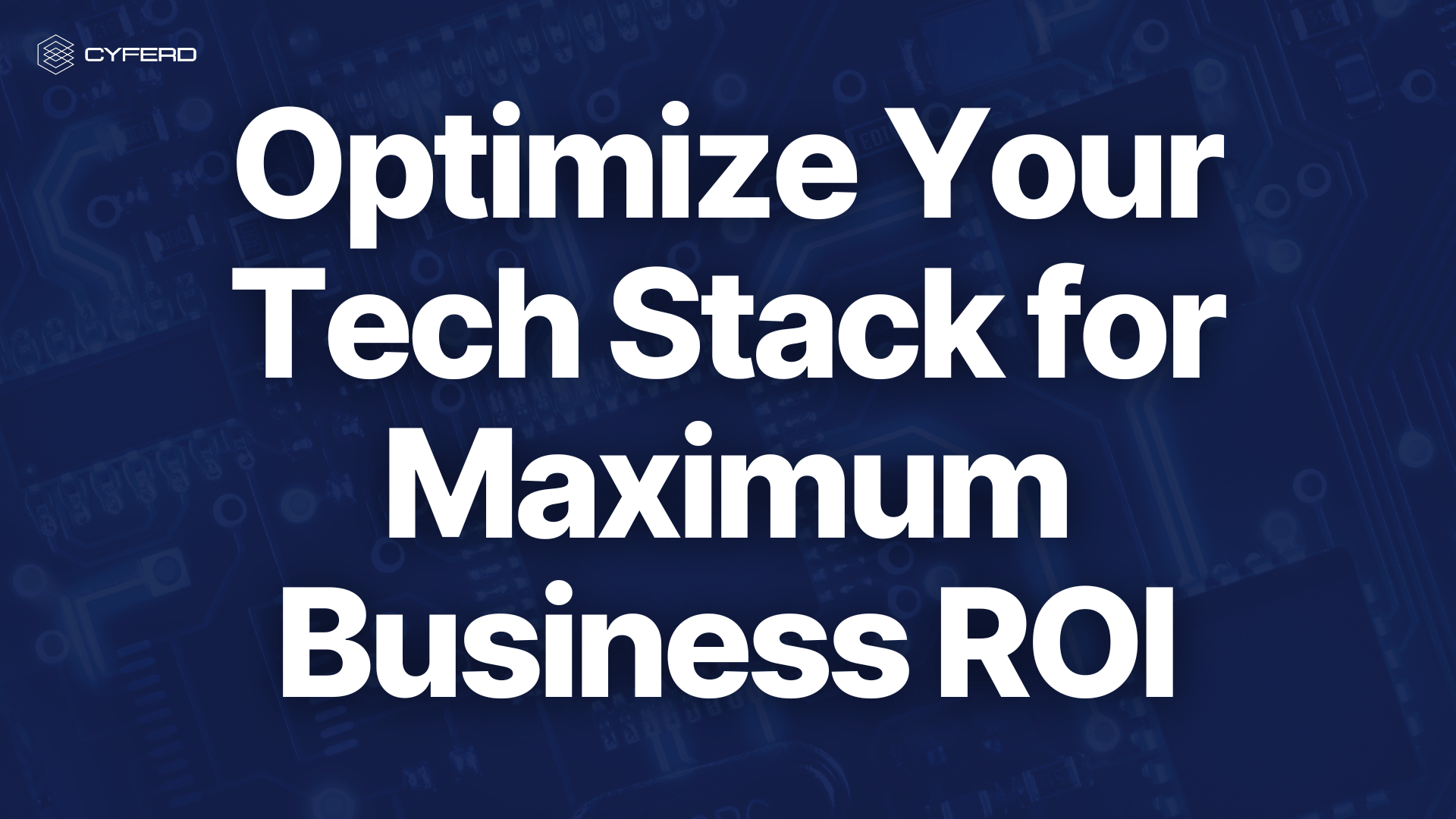Business

Optimize Your Tech Stack for Maximum Business ROI
Drowning in tools that were supposed to make life easier? You’re not alone.
Businesses often pile on platforms, tools, and subscriptions—each one meant to solve a specific issue. But instead of creating clarity, this tech bloat leads to confusion, inefficiencies, and spiraling costs.
The fix? A smarter, more strategic approach to your tech stack.
Tech stack optimization isn’t about slashing tools, it’s about making your technology work as one cohesive, high-performing unit. When done right, it aligns with your goals, streamlines operations, and delivers measurable ROI.
From Support to Strategy: Rethinking Software’s Role
Software doesn’t just support your business, it shapes it. It impacts how you engage customers, manage operations, and empower your teams.
But when your stack grows without direction, cracks appear:
- You’re using five tools to do the job of one.
- Legacy systems linger simply because they “still work.”
- Teams work in silos, slowing down innovation.
Optimizing your stack means elevating software from a tactical tool to a strategic driver. It’s not about more—it’s about better.
Spot the Signs: Is Software Overload Holding You Back?
The average company uses over 100 SaaS applications. But how many are actually driving value?
Common red flags:
- Teams constantly switching tools to complete simple tasks
- Manual data entry and duplicated effort
- Rising license costs and unused subscriptions
- Uncertainty over which system owns what
- Using spreadsheets for workarounds
A 2022 study in SAGE Open found that misaligned IT systems and poor software governance are key contributors to failed digital strategies.
The first step toward change? A full tech audit.
Inventory what you have, who uses it, and whether it’s delivering value—or draining it.
Streamline to Accelerate Transformation
Digital transformation isn’t about adding—it’s about refining.
The goal: Build a lean, adaptive digital core that supports innovation, not complexity.
Here’s how:
- Align tools with business goals (e.g., improve retention, speed up delivery)
- Eliminate overlap—keep only what adds value
- Favor platforms with built-in integrations to minimize fragmentation
- Go cloud-native for scalability, security, and lower overhead
Complexity is a silent tax on your operations. Streamlining pays dividends.
5 Practical Ways to Optimize Your Tech Stack
Let’s move from theory to action. These proven techniques drive ROI and reduce friction:
- Audit routinely – Quarterly reviews prevent waste and surface hidden risks.
- Prioritize integration – Use APIs, iPaaS tools, or middleware to connect the dots.
- Choose cloud-native platforms – They scale faster and integrate more easily.
- Centralize management – Consider a composable application platform to unify your stack.
- Listen to your users – Frontline teams know where bottlenecks live.
Remember: Optimization isn’t about cost-cutting alone. It’s about creating a tech environment that works for your people and your goals.

Align Systems with Smarter Processes
Even the best tools can’t fix broken workflows.
Tech stack optimization works best when it’s paired with process improvement.
Disjointed systems across siloed teams drag down productivity. Integration and workflow alignment close those gaps.
Build Seamless Integration, Not Silos
Integration is what turns a “collection of tools” into a cohesive ecosystem.
Best practices:
- Map your current systems and data flows
- Standardize data formats to improve compatibility
- Leverage APIs or prebuilt connectors
- Prioritize security and compliance (e.g., GDPR, HIPAA)
Example:
A retailer uses separate platforms for inventory, orders, and customer service. Integration creates a single customer view—improving experience, speeding resolution, and enabling upsell opportunities.
Design Workflows That Actually Work
Your tech should support how your teams operate—not force workarounds.
Here’s how to align workflows with your stack:
- Document processes and identify friction points
- Redesign inefficient workflows before automating them
- Train teams to ensure adoption
- Measure impact using KPIs (e.g., time saved, task completion rate)
The result: A business engine that’s efficient, scalable, and built for change.
Cut Costs, Boost ROI
Yes, you’ll save money—but that’s just the start.
ROI comes from:
- Eliminating unused licenses and duplicate tools
- Automating repetitive tasks
- Reducing training costs with a standardized platform
- Accelerating team output and decision-making
Don’t just measure savings—measure momentum.
Track gains like faster time-to-decision, improved customer satisfaction, or higher automation rates.
Break Free from Fragmentation
It often starts with a niche tool or aging CRM. Over time, unconnected systems harden into silos—and that’s where progress goes to die.
Modernize Without the Mayhem
Worried about replacing legacy systems? You don’t have to rip and replace.
Instead:
- Identify outdated systems that are still mission-critical
- Create a phased migration plan
- Use microservices or middleware as a bridge
- Transition slowly to cloud-native, modular components
This approach minimizes risk while moving you closer to a flexible, modern architecture.

The Future Is Composable and Connected
Say goodbye to one-size-fits-all. Say hello to composable architecture, a modular system of interchangeable building blocks that lets you adapt fast and scale smarter.
This is where Cyferd shines. As a composable, AI-enhanced platform, Cyferd brings together your disparate systems, data, and workflows into one unified environment. Instead of juggling multiple tools and platforms, Cyferd gives you the flexibility to build, deploy, and adapt applications quickly without starting from scratch.
Why it works:
- Flexibility to adapt to change – Build once, reuse everywhere. Cyferd lets you configure solutions dynamically as your needs evolve.
- Faster rollout of new capabilities – Launch new features in days, not months.
- Rapid innovation – With a composable core and built-in AI, Cyferd turns your tech stack into a launchpad for continuous improvement.
In a landscape where agility wins, Cyferd replaces fragmentation with cohesion and transforms complexity into competitive advantage.
Supercharge Your Stack with AI
Once your stack is streamlined, AI becomes a game-changer—not a gimmick.
Unlock next-level performance with:
- Automated workflows to eliminate manual tasks
- Personalized experiences for customers
- 24/7 support through AI-powered agents
Tip: Start small. Pick one use case, clean your data, and build from there.
Final Thoughts: Build Smarter, Not Bigger
Optimizing your tech stack isn’t a backend task—it’s a frontline growth strategy.
By aligning technology with your business goals, you:
- Clear operational clutter
- Increase agility
- Reduce cost
- Unlock new value through AI and integration
So, before you buy another tool, ask if your current stack is working together—or against you.
Want to dive deeper?
Register for our upcoming webinar to explore real-world examples, practical optimization tips, and how to build a tech stack that actually drives ROI.
Sources:
Find out more About Cyferd
New York
Americas Tower
1177 6th Avenue
5th Floor
New York
NY 10036
London
2nd Floor,
Berkeley Square House,
Berkeley Square,
London W1J 6BD
